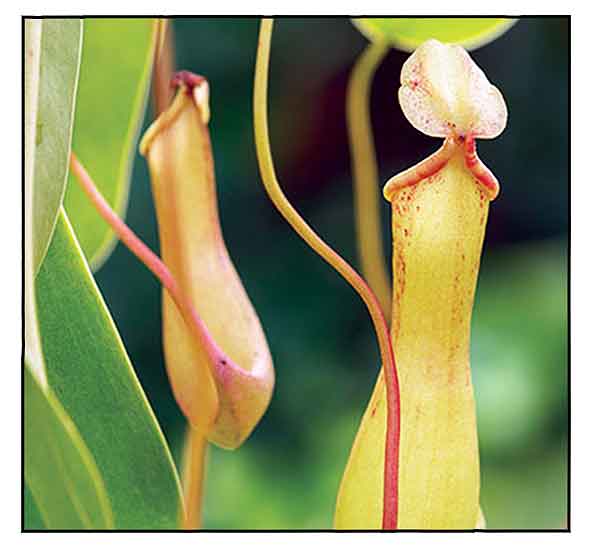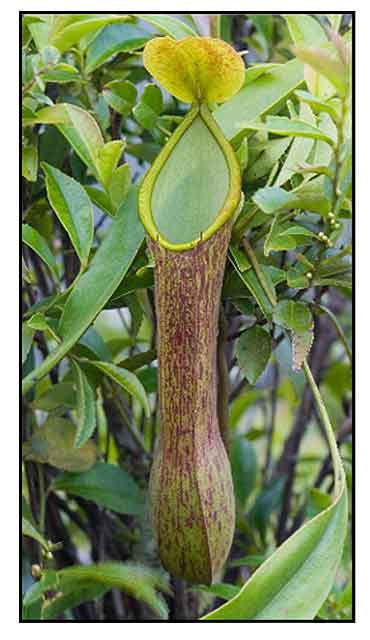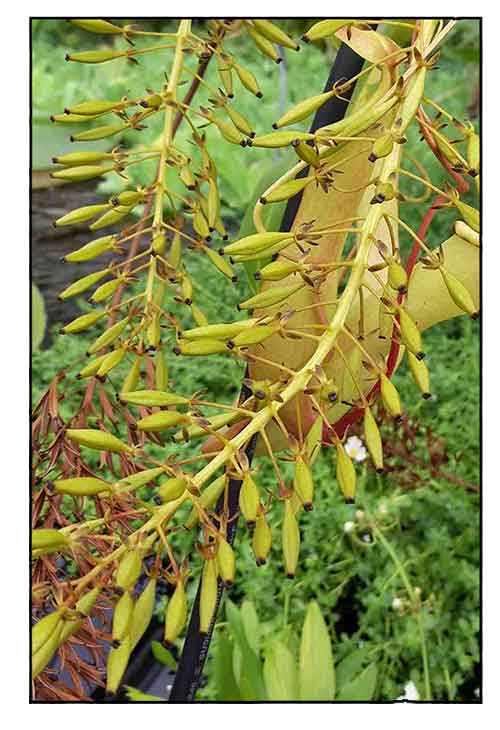 Gen info Gen info
- Nepenthes is a genus of carnivorous plants popularly known as 'pitcher plants' in the monotypic family Nepenthaceae.
-
The genus comprises about 140 species distributed throughout Madagascar, the Seychelles, tropical Asia to Australia. The greatest diversity occurs on Borneo, Sumatra, and the Philippines.
- All species are carnivorous, using its nectar to attract, trap and capture insects and other prey in pitcher-shaped prey-trapping leaves. The insects drown and are digested by the plant enzymes.
- They have been referred to as 'monkey cups' referring to an observation than monkeys drank rainwater from the pitchers.
- It is a highly polymorphic species spanning all islands of the Philippine archipelago with the possible exception of Palawan. Its taxonomy continues to undergo revisions; species have been re-interpreted, delimited and redelimited, resurrected, and reassigned.
- The earliest known record of Nepenthes dates back to the 17th century. In 1658, French colonial governor Etienne de Flacourt published a description of the plant in his seminal work Histoire de la Grande Isle de Madagascar. (5)
- Etymology: The genus name derives from old Greek adjective 'nipenthos' from the negative 'ne, non' and 'penthos' meaning 'sadness, pain', referring to the drink 'nepenthes pharmakon' that Helen furtively served her guests to soothe memories and the pain and homesickness for their native land. The specific epithet alatus means 'wing', given by Spanish friar Manuel Blanco, referring to the membranous wing-like extensions on the ascidia of the plants. (6)
- Nepenthes alata is one of the easiest and most popular in cultivation
 Botany Botany
Nepenthes alata has up to 4 m tall climbing stems, persistently pubescent, with bright green leaves, mostly scattered, rarely alternate, with petiole, somewhat coriaceous, lanceolate-ovate, 10 to 20 cm long and 2 to 5 cm broad, acute or incised only at the apex. The flap gradually fades on the petioles that are winged, 6 cm long, and embrace part of the stem. Young leaves are covered by dense and long white or reddish hairs that often hide the epidermis. With growth the pubescence tends to disappear from the stems and from the lower pagina of the leaves. The median vein of the leaves extends into a tendril which widens at the apex to assume the shape of a cup, the so-called ascidium (from the Greek ἀσκίδιον, “small wineskin”), inside of which forms a cavity that represents the trap these plants use to seize their preys. Basal ascidia are sub-cylindrical, slightly narrowed at the centre with two winged ribs going from top to bottom in the front with small teeth at the margins for catching the crawling insects. The opening of the ascidium is oblique with a reinforced margin (peristome) of red color. The ascidia of the climbing stems are slightly smaller than the lower ones, 8 to 16 cm tall, rarely up to 25 cm, with wings fringed at the top for catching the flying insects, and outer surface covered, for more than the 50%, of small white starred hairs, 0,2 mm broad, standing side by side. Operculum is flat, ovate, longer than wide, with nectariferous glands, raised to 45° on the horizontal plane to prevent rain to dilute digestive fluids. At the base of the lid stands a whole and sharply pointed spur. The ascidia are of pale green color, often with reddish or violaceous spots. Flowers are unisexual and grouped in male and female racemose inflorescences on different plants. The female inflorescences are like the male ones but are averagely shorter. Each flower is formed by four tepals and is supported by a 10-15 mm long peduncle. Male flowers have the stamens with the filaments merged in column, and exceed, anthers included, the tepals of about 5 mm. Female flowers present a superior ovary, ovoid, sessile, tomentose with numerous ova. The fruits are coriaceous capsules loculicidal, dehiscent, with 4 valves containing many filiform seeds, 8-10 mm long. (6)
 Distribution Distribution
- Native to the Philippines.
- Reported in the islands of Bohol, Camiguin, Cebu, Culion, Leyte, Luzon, Mindanao, Mindoro, Negros, Panay, Samar and Sibuyan, at altitudes from 0-1,900 ft above sea level.
Constituents
- Ground and extracted air dried plant of N. alata, isolated and fractionated, led to the isolation of three known flavonoids: quercetin-3-O-ß-D-glucuronide, quercetin-3-O-α-L-rhamnopyranoside, and kaempferol-3-O-α-L-rhamnopyranoside. (14)
Properties
- Can vary strongly in coloration and morphology.
-
Studies have suggested anticancer, antimicrobial, bactericide, fungistatic properties.
Parts used
Pitchers, stems, roots.
Uses
Folkloric
- The Ayta community of Porac, Pampanga, use the plant (baso ng binangonan) for treatment of snakebites. (11)
- In the Cordillera, used to cure hangovers.
- Stems and roots chewed for toothaches
Studies
• Plumbagin / Anticancer / MCF-7 Breast Cancer Line: Plumbagin (5-hydroxy-2-methyl-1,4-naphthaquinone) has displayed antitumor activity in vitro and in animal models. Study evaluated the anticancer effects of plumbagin isolated from Nepenthes alata against MCF-7 breast cancer cells. Plumbagin exhibited potent cytotoxicity in MCF-7 cells (wild-type p53). Plumbagin upregulated the expression of p21 in MCF-7 cells, causing cell cycle arrest in G2/M phase through inhibition of cyclin B1 levels. Plumbagin exerts anticancer activity against MCF-7 cells through generation of intracellular ROS, resulting in induction of apoptosis via a p53-dependent pathway. Study identifies a new anticancer mechanism of plumbagin against p53-dependent breast cancer cells and a novel strategy in breast cancer therapy. (3)
• Antimicrobial / Roots: Study evaluated the cytotoxicity and antimicrobial activity of ether crude extract of dried powder roots from pitcher plant. Vacuum liquid chromatography isolated an active compound 7A-III. The compound 7A-III showed an LC50 of 4.42 ppm against brine shrimp larvae. It exhibited high degree of antimicrobial activity against Staphylococcus aureus and slight inhibitory activity against E. coli and Candida albicans. Brine shrimp lethality and antimicrobial activity was attributed to phenolic moiety isolated from the roots. (8)
• Inhibition of Pseudomoas aeruginosa / Pitcher: Study evaluated the antibacterial activity of ethanolic extracts of 13 indigenous plants from the Cordillera region against Pseudomonas aeruginosa. Nepenthes alata showed lowest minimum inhibitory concentration (MIC) at 250 µg/mL. In a 2012 study, Buch and his colleagues demonstrated that pitcher fluid contained antimicrobial naphthoquinones, plumbagin and 7-methyl-jjuglone and defensive proteins such as thaumatin-like protein. Naphthoquinones can reduce bacterial biofilm formation up to 50%. (9)
• Bactericidal, Self-Cleaning, Insect Anti-Adhesive / Nepenthes-Inspired Nanoblades: Inspired by slippery zone of Nepenthes, study prepared a multifunctional nanostructured surface with mechanical bactericidal, self-cleaning, and insect anti-adhesive characteristics. Slippery zones were cut from Nepenthes alata pitchers. The ANB s surface successfully mimic the self-cleaning and insect anti-adhesive performance of NSZ surface. The multifunctional surface has promising potential for application in sustainable applications avoiding the abuse of sterilizing agent, inhibiting the pernicious environment pollution and preventing high hazard vector-borne diseases. (10)
• Influence of Nitrogen Sources of Leaf Carnivory: Study evaluated the effect of different nitrogen (N) sources on Nepenthes alata photosynthesis and N metabolism in the greenhouse. N was given as either inorganic, organic N derived from meal worms, Tenebrio molitor, or both for a period of four weeks. Results suggest that organic prey N is essential for N. alata to achieve higher photosynthetic capacity and N metabolism only when plants are subjected to an environment where inorganic N is scarce. (12)
• Composition of Digestive Fluid / Bactericide and Fungistatic: The carnivorous plants of the genus Nepenthes possess modified leaves that form pitfall traps to capture prey, mainly arthropods, to make additional nutrients available for the plant. The pitchers contain a disgestive fluid due to presence of hydrolytic enzymes. Study evaluated the composition of the digestive fluid, its mineral nutrients and potential contribution of microbes to the composition of the fluid. Results showed the fluid is free of bacteria and unsuitable for microbial growth probably due to lack of mineral nutrients such as phosphate and inorganic nitrogen. The fluid contained antimicrobial naphthoquinones, plumbagin and 7-methyol-juglone, and defensive proteins such as thaumatin-like protein. Results revealed two features: (1) the pitcher fluid is a dynamic system able to react to challenge of microbe infections; and (2) when challenged with microbes and fungi, the fluid can exhibited bactericide and fungistatic properties. (13)
• Proteome Analysis of Pitcher Fluid / Inhibitors of Bacterial Growth: The genus Nepenthes comprises carnivorous plants that digest insects in pitcher fluid to supplement their nitrogen intake. A recent study purified two acid proteinases (nepenthesins I and II) from the protein fluid. Study performed a proteomic analysis to identify all the protein involved. Proteins identified included homologues of ß-D-xylosidase, ß-1,3-glucanase, chitinase, and thaumatin-like protein, most of which were designated "pathogenesis-related proteins". The proteins presumably inhibit bacterial growth in the pitcher fluid to ensure sufficient nutrients for Nepenthes growth. (15)
Availability
- Wild-crafted.
- Plants in the cybermarket.
|

![]()






